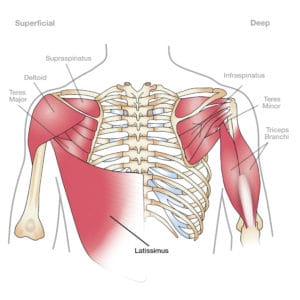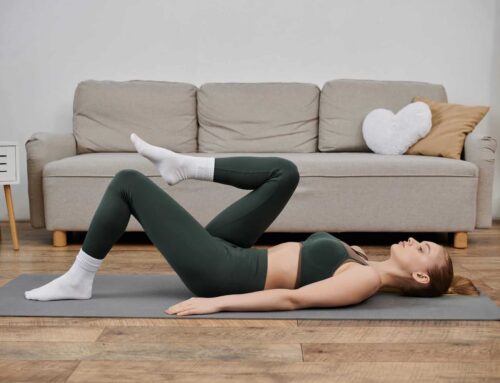Introduction
There are 17 muscles that attach to your shoulder blade alone, and any number of them might be the one causing your symptoms. However, one muscle that frequently plays a role in shoulder pain is the pec minor – when it’s restricted, it can lock down your shoulder and cause pinching with overhead motions.
The 3 exercises we outline below to ease shoulder pain, when performed in sequence, give you a strategy to eliminate the impact of the pec minor on your shoulder restriction. Soft tissue release warms up the tissue, then you stretch it, then you strengthen the muscles that pull against it.
Try these exercises consistently for 2 weeks and you should feel considerable relief from your symptoms. If you’d like faster relief, or you just can’t seem to get ahead of your symptoms, it’s time to work with a professional.

Soft Tissue Mobilization With Lacrosse Ball
Soft tissue mobilization is commonly performed with a foam roller or a lacrosse ball. The goal is to increase blood flow to the tissue in order to improve range of motion and decrease pain. The pec minor attaches from the ribs to the front of the shoulder blade as shown in the picture above. Lack of flexibility can contribute to a forward tipping and downward rotation of the shoulder blade. This can lead to restricted motion and a pinching feeling in the shoulder as you reach or lift. Apply a moderate amount of pressure to various points on the muscle that is located in the front of the chest, from the shoulder area diagonally toward the sternum. Hold pressure on tender areas for 20-30 seconds as the tension decreases, then move to a new spot and repeat. You can also add some active arm movements while maintaining pressure.
- If you’re looking for something that focuses on more mobility, try out our “Four Tips For Shoulder Pain” blog.
Doorway Stretch
After soft tissue mobilization, a prolonged stretch can be applied to the muscle. The purpose of the stretch is to elongate the soft tissue that has been stimulated using the lacrosse ball or foam roll for mobilization. Stretching improves range of motion. In this case, by stretching the pec minor, we increase the range of motion of the shoulder blade as well as the shoulder joint itself, which allows higher pain-free reaching and lifting. Hold this stretch for about 30 seconds, and do it 3 times per arm. You can also try a contract-relax version, where you push into the wall gently for 3-5 seconds prior to each stretch.
- For more great exercises to ease shoulder pain you can go to “4 Great Shoulder Shoulder Exercises” to see what movements give you the most relief.
Prone Y
Now that you’ve gained range of motion, you just have to maintain it! But how do you do that? By using and strengthening muscles that work opposite those that you just stretched out. Let me introduce you to the lower trapezius – the red part of the muscle in the picture above. This muscle can counteract the pec minor, by acting to upwardly rotate and tip the shoulder blade back – both of which are necessary motions for arm elevation. By strengthening this muscle into your newly-gained range of motion, you can reinforce and better maintain this increased and pain-free mobility. Initially, to work on endurance of this muscle, start with 3 sets of 15- 20 repetitions.
- Read a patient success story going over how we were able to rehabilitate her shoulder based on her posture and how she walked.
Not Enough?
If these exercises aren’t quite getting you the results you seek, you may need more focused and individualized treatment.
The best way to ease shoulder pain or to eliminate it completely, and get you back to lifting and reaching without restrictions, is to see a physical therapist for a detailed examination and specific intervention.
Click the button below to request a FREE quick 15 minute phone consultation with one of our shoulder experts to see if physical therapy is right for you!
No Obligation
All Questions Answered
FREE






